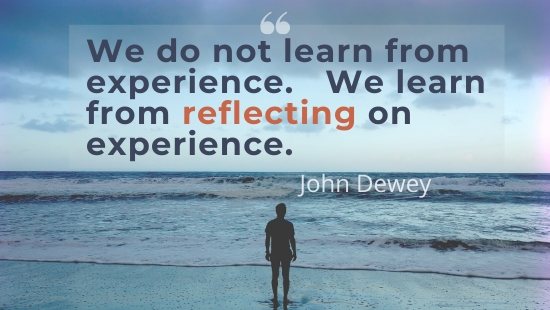We know post-mortem reviews, also called after-action reviews, are essential to getting better as an individual and as a team, but they can be tricky to execute well. Learn how to get the most from your post-mortem review, and download all the tools you’ll need in my new “Essential Guide to Post-Mortem Reviews” PDF.
Project post-mortem (PPM) reviews are essential to getting better as an individual and as a team. It’s not enough to acquire experience; we must be deliberate in how we reflect on and learn from that experience.
In a recent Harvard Business School study, researchers found “individuals who engage in deliberate learning efforts experience higher performance improvements as compared to individuals who have simply accumulated additional experience.”
Benefits of Post-Mortem Reviews
High performance is always a desired benefit, but there are three equally impactful benefits of PPM reviews we should consider: closure, confidence, and camaraderie.
Closure
PPM’s provide the perfect opportunity to get closure after a project wraps up or passes a significant milestone. Teams often move from one project to the next with unresolved questions, differences, or even conflicts that create tension that carries over to the next project and can escalate, if left unchecked.
Confidence
Whether a project went well or crashed and burned, a PPM helps teams build confidence in their capabilities. If a project went well, the review uncovers why it was successful and how to leverage actions in the future.
If the project failed, the PPM allows the team to discover why and what they would do differently next time. This deliberate learning empowers organizations to have the confidence to take another swing, not shrink from the failure.
Camaradarie
When teams can come together to evaluate candidly, and without judgment, they build the kind of camaraderie required of high-performance team. The PPM gives people a chance to be heard and build trust in the process.
Getting the Most From Post-Mortem Reviews
Getting the most out of your post-mortem requires a bit of coordination and planning. You’ll want to do it soon after a project wraps up while memories are still fresh. Here are the steps you can follow to have a great review.
Step 1: Gather Internal/External insights In Advance
Get feedback from clients/customers to get an external perspective on the project. For internal insights, people may be hesitant to share feedback in an open forum so give them a chance to share feedback anonymously through surveys.
These surveys can also be used to include feedback from people who may not be attending the session. (I’ve included survey question examples in the downloadable guide.)
Step 2: Invite the Right People
The tendency is to include as many people as possible but resist! Use the post-mortem survey to give those involved with the project a voice. For the actual post-mortem review session, include only no more than 7 to 10 of the people who were most involved in the project.
Step 3: Send the Agenda and Insights
Priming is an essential step in the process, so send out the agenda and the insights gained from the surveys in advance of the meeting.
You don’t need to summarize or make any judgments about these insights gained. Leave that for the individual team members to determine, as you will discuss more in the meeting.
Step 4: Conduct the Post-Mortem Review
- Discuss the project goals. Pick a person (or ask for volunteer) to describe what the organization’s goals were for the project. What did we think would happen? After the person finishes, let the group add to this part of the story.
- Discuss what the results were. What happened? Pick another person (or ask for a volunteer ) to describe the outcome of the project. Do this in an objective way that avoids blame or judgment. Ask the group if they would like to add anything to complete this story.
- What went well, and what didn’t? As a group, make a list of everything that worked well and a separate list of what didn’t. Dig into the why behind the group’s answers.
- Decide what to keep and what to change. Shift to future thinking and ask, “If we were to do this project again, what would we keep, and what would we change?” Avoid broad generalizations. Instead, use specific, actionable examples to leverage for future projects.
- Assign responsibility. Identify one person to be responsible for making sure the next steps occur for each of the ideas listed.
- Close with the positive. Remind the team of all the good things they have experienced on the journey they have shared. Reinforce the success, the learning, and the excellent work the team has achieved.
Step 5: Share Results of the Post-Mortem Review
The learning experience multiplies when the entire organization can learn from project post-mortems. At a minimum, share the results with everyone who worked on the project. I recommend going a step further and creating a library of the PPM reviews hosted in a location that everyone in the organization can easily.
This library would be an excellent resource for project leaders and teams to refer to when kicking off that next big project.
NOTE: Ideally, an outside facilitator would be best to guide this session. (Contact me if you’d like to have me facilitate your next post-mortem review). If that is not an option, select a facilitator that can be objective – preferably one who was not central to the project.
Download “The Essential Guide to Post-Mortem Reviews”
If we did project PPM reviews on big projects alone, we would make tremendous strides in improving outcomes. But if we made efforts to institutionalize this process, we could level-up the impact. One way to do this is to require project teams to share their post-mortem results with the Leadership Team for the significant projects. Doing this would allow teams to address misunderstandings or beliefs the Leadership has about the project that might be harmful if left unaddressed.
Hard-work and discipline are required to perform PPM reviews. They can be uncomfortable, and frankly, some people want to just put the project behind them. But if you can power through the process of deliberate learning, the closure, clarity, and camaraderie will make it worth it.
Please share your thoughts with me on this, and if you’ve found this information helpful, you can help me get the word out by using the links provided and sharing it with a colleague. Thanks!
Work well,



Great insights. Thanks!
You’re welcome, Kent. Thanks so much for taking the time to leave a comment!